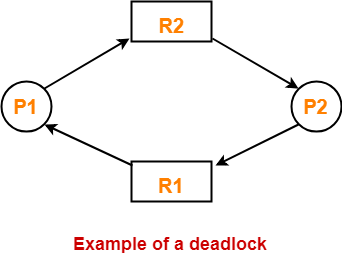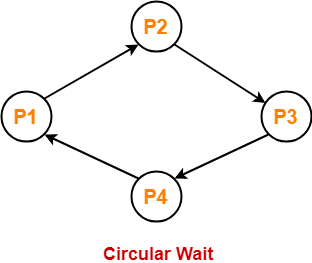Deadlock Handling-
Before you go through this article, make sure that you have gone through the previous article on Deadlock in OS.
The various strategies for handling deadlock are-

- Deadlock Prevention
- Deadlock Avoidance
- Deadlock Detection and Recovery
- Deadlock Ignorance
Deadlock Prevention-
- This strategy involves designing a system that violates one of the four necessary conditions required for the occurrence of deadlock.
- This ensures that the system remains free from the deadlock.
The various conditions of deadlock occurrence may be violated as-
1. Mutual Exclusion-
- To violate this condition, all the system resources must be such that they can be used in a shareable mode.
- In a system, there are always some resources which are mutually exclusive by nature.
- So, this condition can not be violated.
2. Hold and Wait-
This condition can be violated in the following ways-
Approach-01:
In this approach,
- A process has to first request for all the resources it requires for execution.
- Once it has acquired all the resources, only then it can start its execution.
- This approach ensures that the process does not hold some resources and wait for other resources.
Drawbacks-
The drawbacks of this approach are-
- It is less efficient.
- It is not implementable since it is not possible to predict in advance which resources will be required during execution.
Approach-02:
In this approach,
- A process is allowed to acquire the resources it desires at the current moment.
- After acquiring the resources, it start its execution.
- Now before making any new request, it has to compulsorily release all the resources that it holds currently.
- This approach is efficient and implementable.
Approach-03:
In this approach,
- A timer is set after the process acquires any resource.
- After the timer expires, a process has to compulsorily release the resource.
3. No Preemption-
- This condition can by violated by forceful preemption.
- Consider a process is holding some resources and request other resources that can not be immediately allocated to it.
- Then, by forcefully preempting the currently held resources, the condition can be violated.
A process is allowed to forcefully preempt the resources possessed by some other process only if-
|
4. Circular Wait-
- This condition can be violated by not allowing the processes to wait for resources in a cyclic manner.
- To violate this condition, the following approach is followed-
Approach-
- A natural number is assigned to every resource.
- Each process is allowed to request for the resources either in only increasing or only decreasing order of the resource number.
- In case increasing order is followed, if a process requires a lesser number resource, then it must release all the resources having larger number and vice versa.
- This approach is the most practical approach and implementable.
- However, this approach may cause starvation but will never lead to deadlock.
Deadlock Avoidance-
- This strategy involves maintaining a set of data using which a decision is made whether to entertain the new request or not.
- If entertaining the new request causes the system to move in an unsafe state, then it is discarded.
- This strategy requires that every process declares its maximum requirement of each resource type in the beginning.
- The main challenge with this approach is predicting the requirement of the processes before execution.
- Banker’s Algorithm is an example of a deadlock avoidance strategy.
Deadlock Detection and Recovery-
- This strategy involves waiting until a deadlock occurs.
- After deadlock occurs, the system state is recovered.
- The main challenge with this approach is detecting the deadlock.
Deadlock Ignorance-
- This strategy involves ignoring the concept of deadlock and assuming as if it does not exist.
- This strategy helps to avoid the extra overhead of handling deadlock.
- Windows and Linux use this strategy and it is the most widely used method.
- It is also called as Ostrich approach.
To gain better understanding about Deadlock Handling Strategies,
Next Article- Practice Problems On Deadlock
Get more notes and other study material of Operating System.
Watch video lectures by visiting our YouTube channel LearnVidFun.

